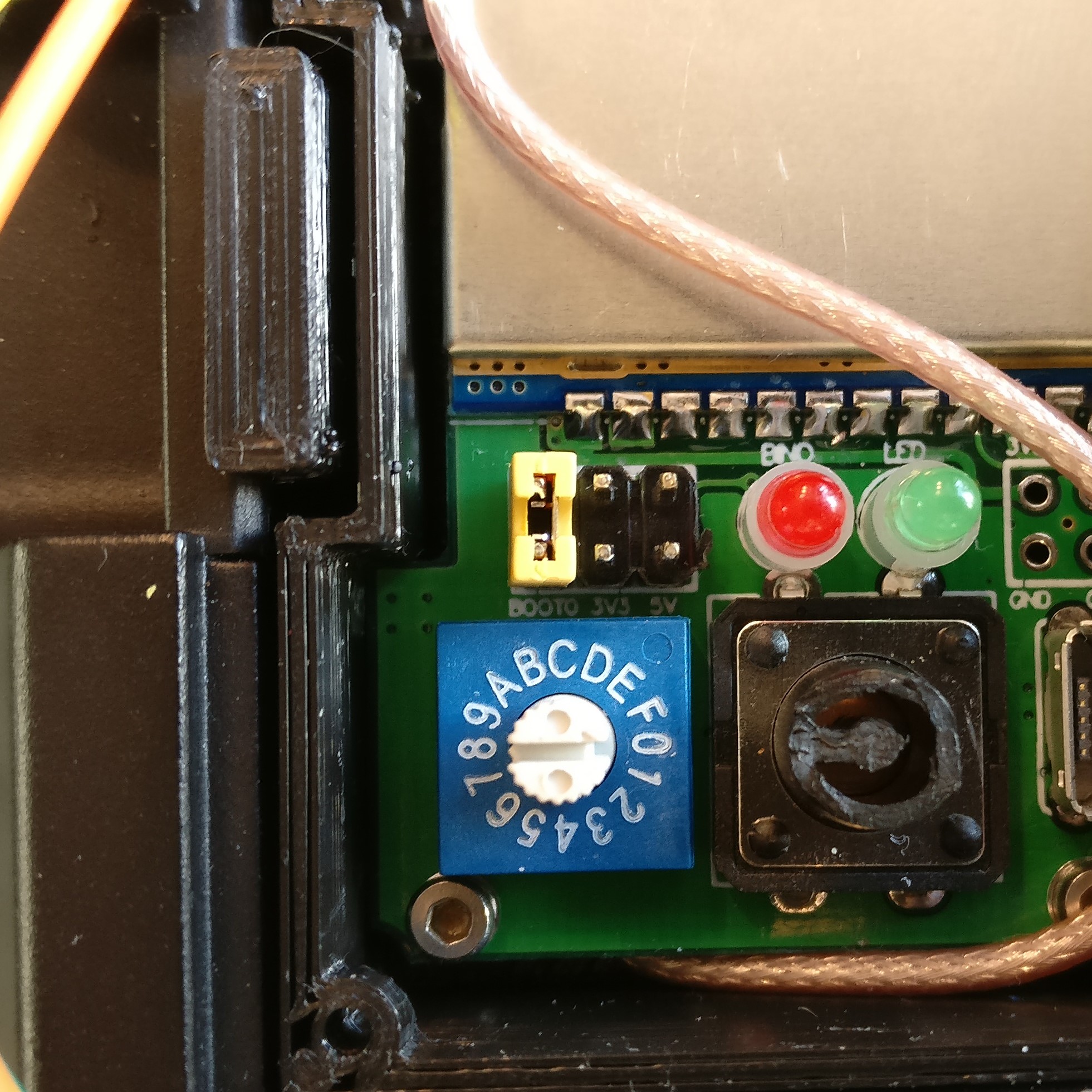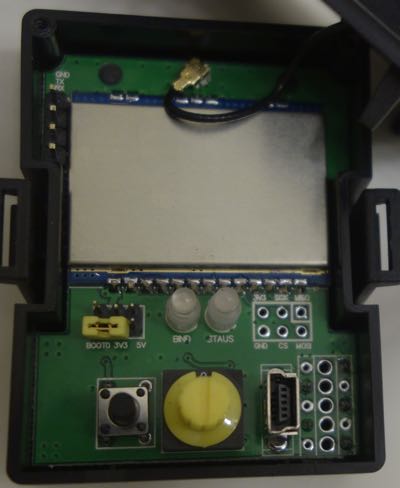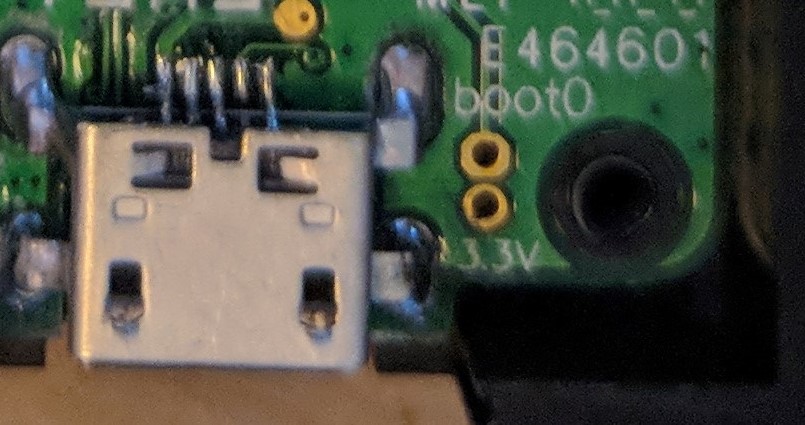19 KiB
Compiling and Programming (STM32)
Multiprotocol firmware is compiled using the Arduino IDE. The guide below will walk you through all the steps to compile and upload your customized firmware.
These instructions are for the STM32 version of the Multiprotocol module. If you are Compling for the Arduino ATmega328p version of the Multiprotocol Module please go to the dedicated ATmega328 page.
Index
- Tools Required
- Preparation
- Configure the firmware
- Verify the firmware
- Preparing to upload the firmware
- Upload via Serial inc. Bootloader (FTDI)
- Flash from TX
- Upload via USB
- Precompiled Binaries
- Troubleshooting
Tools required
Notes:
- The Vantac MPM Lite module most likely already has the USB Bootloader flashed on it. You can directly use the upload via USB method. Early modules' bootloader was however not booting everytime, if this is the case you need to upgarde it.
- The latest jumper modules have an integrated FTDI appearing as a CP2102 device on the computer. You therefore don't need the FTDI adapter below and don't need to open your module to flash it.
| 3.3V USB-TTL Adapter | 4-pin Serial Programming Header |
|---|---|
 |
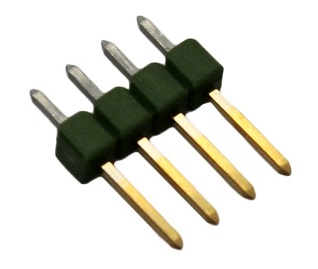 |
| (example ebay link) | (example ebay link) |
The USB-TTL adapter can be either FTDI or CH340G, as long as it works. It should have a switch or jumper to select 3.3V or 5V, which must be set to 3.3V.
The 4-pin header needs to be soldered onto the board as indicated by the red rectangle:
| DIY Multiprotocol Module | Banggood 4-in-1 Module | iRangeX IRX4 Plus Module | MPM Lite |
|---|---|---|---|
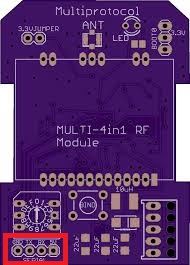 |
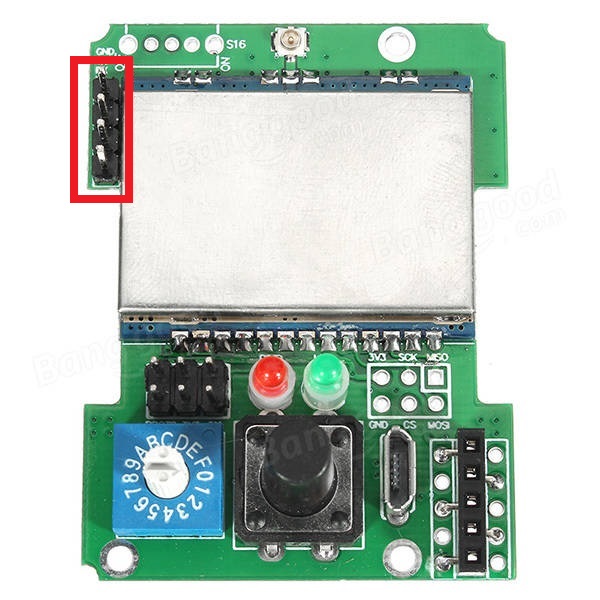 |
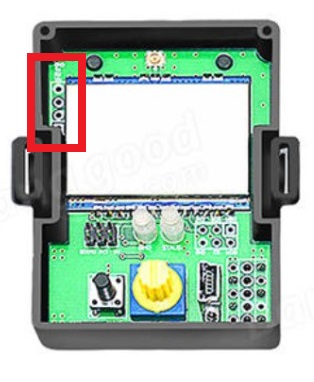 |
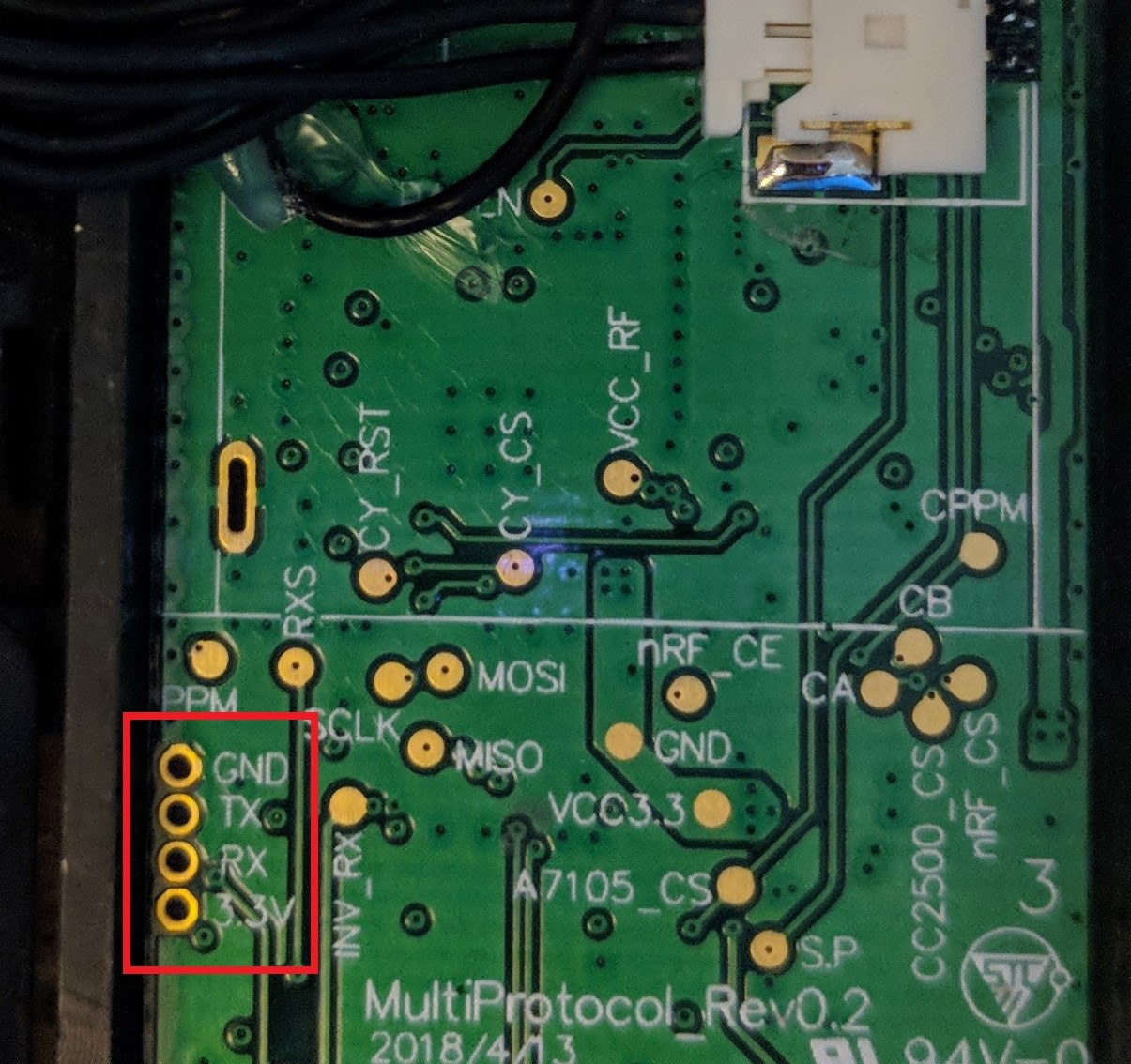 |
Note: The Banggood STM32 module most likely already has the header pin in place.
Preparation
Install the Arduino IDE
- Download and install the Arduino IDE. The currently supported Arduino version is 1.8.5, available for Windows, Mac OSX and Linux (64-bit)
- It is recommended to upgrade Java to the latest version
Download the Multiprotocol source and open the project
- Either
- Download the zip file with the Multiprotocol module source code from here and unzip and copy the source code folder Multiprotocol to a location of your choosing, or
- Clone the project using Git or Github Desktop, then
- Double-click the Multiprotocol.ino file in the Multiprotocol folder to open the project in the Arduino IDE
Install the Multi 4-in-1 board
- Follow these instructions to install the Multi 4-in-1 STM32 Board in the Arduino IDE
Configure the Arduino IDE
- Under Tools -> Board select Multi 4-in-1 (STM32FC103)
- Under Tools -> Programmer select stm32flash (FTDI)
Configure the firmware
The STM32 module has more than enough flash space for all the available protocols so, unlike the Atmega328p-based module, it is not necessary to disable unused protocols.
You can still disable protocols if you wish, and you may also enable or disable other optional Multiprotocol features.
Verify the firmware
To check that the program will compile correctly and fit in the Atmega click Sketch -> Verify/Compile, or press Ctrl+R.
If there are errors, carefully read it, go to the line number indicated and correct your typo.
If there are no errors and you see output like this:
Sketch uses 68564 bytes (52%) of program storage space. Maximum is 131072 bytes.
Global variables use 4064 bytes (19%) of dynamic memory, leaving 16416 bytes for local variables. Maximum is 20480 bytes.
You can proceed to the next step.
Preparing to upload the firmware
If you have already burnt the bootloader, and are simply recompiling firmware to re-flash using your TX or USB cable, you can skip this step and go straight to Flash from TX or Upload via USB.
STM modules, until now, do not come with a preloaded bootloader which makes the USB port unusable and discovered by a computer as unknown device. For the first time use, you must use the upload method Upload via Serial inc. Bootloader (FTDI) independently of what method you wish to use in future.
The latest Jumper 4-in-1 modules come with a USB port but it's in fact a built in FTDI appearing on the computer as a CP2102 serial device. You should use the method Upload via Serial inc. Bootloader instead of Upload via USB. 'Flash from TX' is supported once the bootloader is installed.
Select an Upload Method
There are three methods to upload firmware to an STM32 module:
- Flash from TX - highly recommended, uses maintenance mode in radios running ersky9x or OpenTX to upload the firmware
- Upload via USB - uses the USB port on the module
- Upload via Serial inc. Bootloader (FTDI) - uses the serial interface on the module via a USB-to-TTL adapter
Note: 'Flash from TX' is available with radios supporting ersky9x or OpenTX and running the latest bootloader with the Multi Flash app.
Flash from TX is highly recommended if your transmitter supports it, Upload via USB is recommended for all others. Upload via Serial inc. Bootloader can be used if your module does not have a USB port and your transmitter does not run ersky9x or OpenTX.
- Under Tools -> Upload Method select an upload method
The rest of this process will vary depending on the upload method you selected.
Upload via Serial inc. Bootloader (FTDI)
It is strongly recommended that you power your module from the transmitter when flashing it. This ensures that the module cannot be inadvertently supplied with 5V, which will damage the RF modules. This guide assumes that you will follow that advice, and instructs you to leave the V+ pin on the USB-to-TTL adapter disconnected. You may choose to ignore that advice at your own risk!
The wiring for the USB-to-TTL adapter is:
- USB-to-TTL TX pin <-> Module RX pin
- USB-to-TTL RX pin <-> Module TX pin
- USB-to-TTL GND pin <-> Module GND pin
- USB-to-TTL VC pin <-> Not Connected
It is critical to ensure that the USB-to-TTL adapter is set to 3.3V.
| DIY Multiprotocol Module | Banggood 4-in-1 Module | iRangeX IRX4 Module |
|---|---|---|
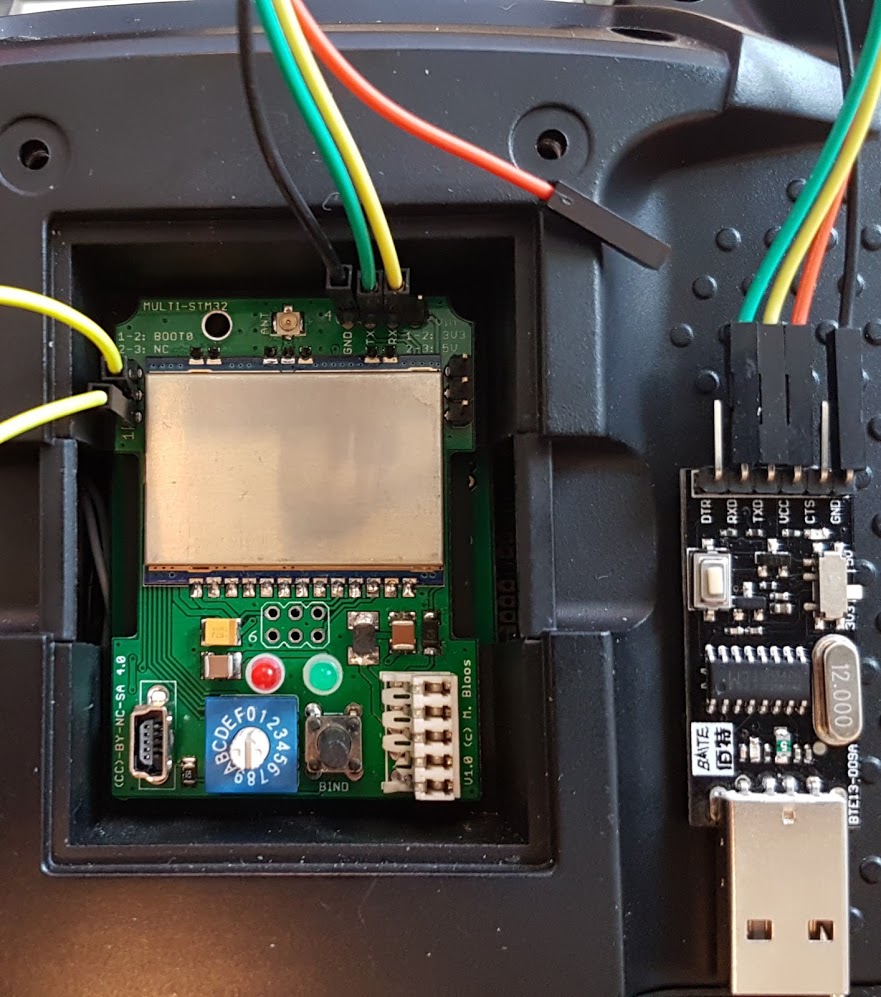 |
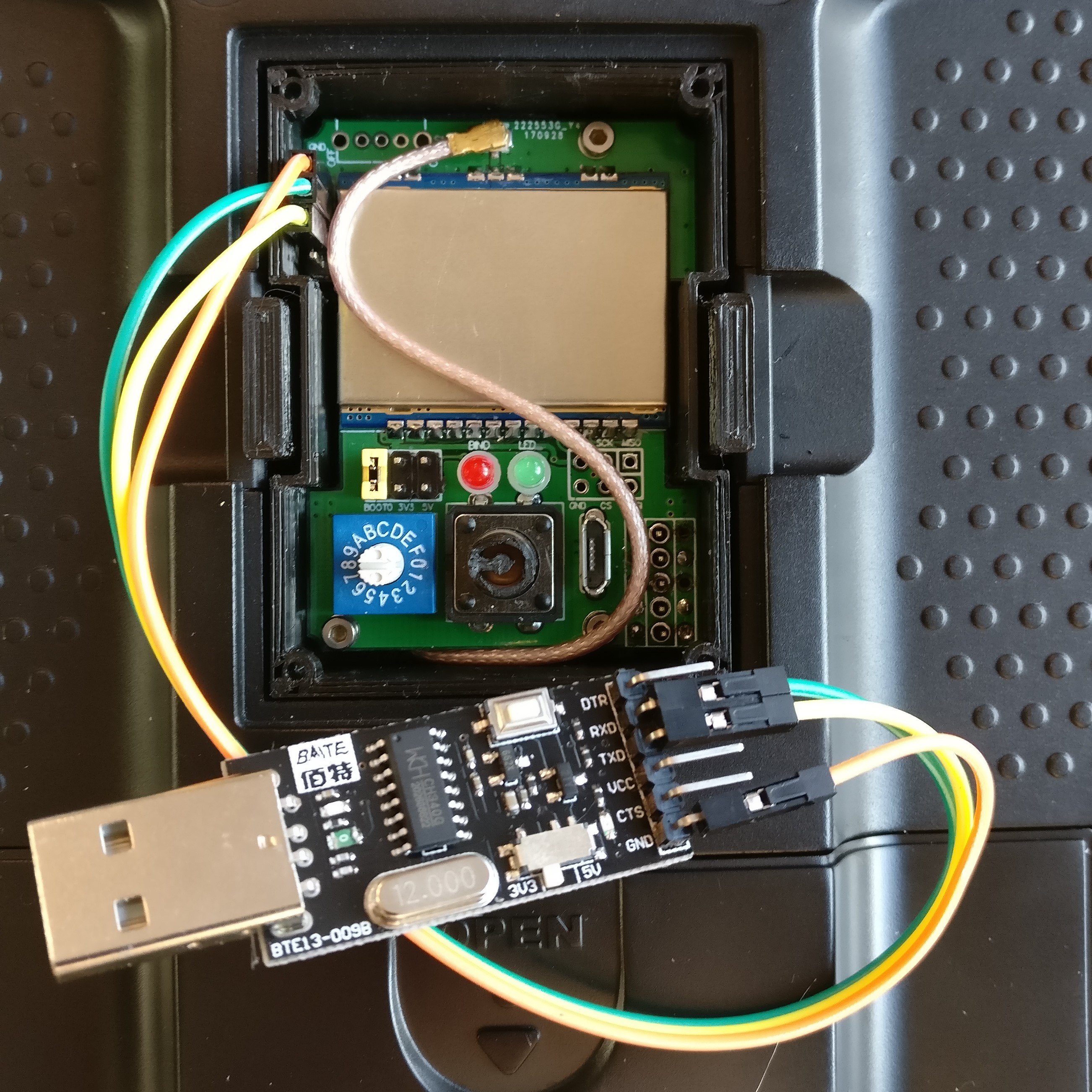 |
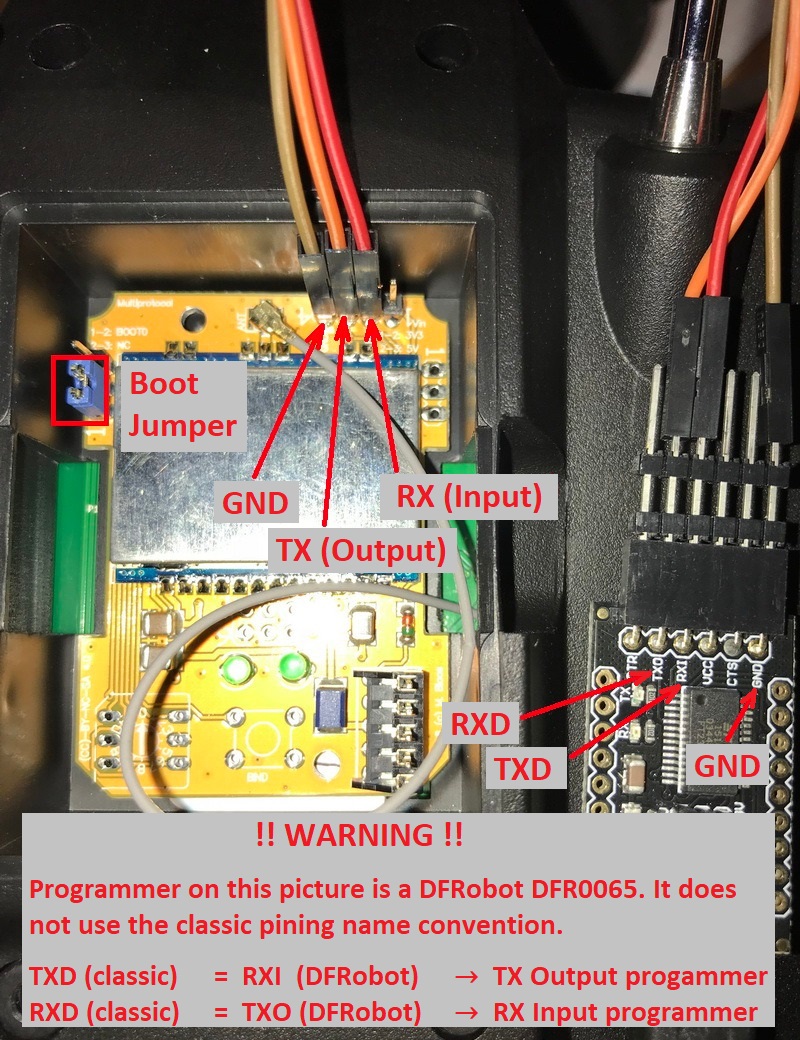 |
- Put the module in the transmitter
- Connect the USB-to-TTL adapter to the module as described above
- Plug the USB-to-TTL adapter into the PC
- In the Arduino IDE click Tools -> Port and choose the COM port which matches the USB-to-TTL adapter
In order to flash the bootloader the BOOT0 jumper must be installed connecting BOOT0 to 3.3V. The location of BOOT0 varies by hardware module. The latest Jumper modules with an intergrated FTDI do not need the BOOT0 jumper.
- If on Linux, ensure you have permissions to access serial interfaces as described in Install the Maple USB drivers
- Install the BOOT0 jumper as described above.
- Switch on the transmitter
- Verify that you have selected the upload method Upload via Serial inc. Bootloader (FTDI) under Tools -> Upload Method
- Verify that you have selected stm32flash (FTDI) as the programmer under Tools -> Programmer
- Verify that the USB-to-TTL adapter is correctly connected to your module and you have selected the correct port under Tools -> Port
Output will look similar to this:
C:\Users\blye\AppData\Local\Arduino15\packages\multi4in1\hardware\STM32F1\1.0.0/tools/win/serial_upload.bat COM4 0x0 C:\Users\blye\AppData\Local\Arduino15\packages\multi4in1\hardware\STM32F1\1.0.0/bootloaders/Multi4in1/StmMultiUSB.bin
stm32flash -v -g 0x0 -b 57600 -w C:\Users\blye\AppData\Local\Arduino15\packages\multi4in1\hardware\STM32F1\1.0.0\bootloaders\Multi4in1\StmMultiUSB.bin COM4
stm32flash 0.4
http://stm32flash.googlecode.com/
Using Parser : Raw BINARY
Interface serial_w32: 57600 8E1
Version : 0x22
Option 1 : 0x00
Option 2 : 0x00
Device ID : 0x0410 (Medium-density)
- RAM : 20KiB (512b reserved by bootloader)
- Flash : 128KiB (sector size: 4x1024)
- Option RAM : 16b
- System RAM : 2KiB
Write to memory
Erasing memory
Wrote and verified address 0x08000100 (3.56%)
Wrote and verified address 0x08000200 (7.13%)
...
Wrote and verified address 0x08001c00 (99.78%)
Wrote and verified address 0x08001c10 (100.00%) Done.
Starting execution at address 0x08000000... done.
Assuming the process is successful:
- Power off the transmitter
- Remove the BOOT0 jumper
- Disconnect the USB-to-TTL adapter
Flash from TX
- Click Sketch -> Export compiled Binary, or press Ctrl+Alt+S
- Locate the file named multifw.bin in the Multiprotocol folder
- Follow the instructions here to upload the firmware using your radio
Upload via USB
In order for the module to be correctly identified in Windows it is necessary to install drivers. This only needs to be done once.
Install the Maple USB drivers
Windows 7 or newer:
- Open the folder where you unzipped or cloned the Multiprotocol project
- Browse to \BootLoaders\Boards\stm32\drivers
- Run install-drivers.bat
- Follow the prompts to install the two drivers
Windows XP or older
- Download and install the legacy Windows XP drivers from here
NOTE: If you have installed the drivers and your module is not detected as a Maple device it most likely does not have a USB bootloader installed. Ready-made modules from Banggood do not come with a USB bootloader installed. You will need to follow the procedure to Burn a USB bootloader before you can upload firmware.
Linux (64-bit)
To execute any of the following commands you should use a Terminal (shell) with the current directory set to the location where you cloned or unpacked this project.
You can do this by navigating to the project folder in the Files application then right clicking and selecting "Open in Terminal" from the menu that appears. This will open a Terminal where you will enter the commands indicated below.
If you are using Ubuntu 16.04 LTS it is not necessary to download Maple USB drivers but your account must have permissions to communicate to the Maple USB system devices. To do this you must be in the group which can access USB devices and/or serial interfaces. This configuration must be done once after account creation/system install. You can do that by entering the following commands:
sudo usermod -a -G plugdev $USER
sudo usermod -a -G dialout $USER
Any sudo operation requires administrator privileges and if your account is an administrator account (and it will be if you installed Ubuntu yourself) it will ask for your password.
After entering these commands you must log out of Ubuntu completely and log back in. Simply closing the Terminal window and opening another will not work.
The first command adds your user account to the group which can access connected USB devices. The second adds your account to the group which can access serial interfaces.
The next steps will change your system's permissions rules so that users in the plugdev group can access attached USB devices.
If necessary, open another Terminal window with the current directory set to the project directory as explained above. Then type the following commands into the Terminal:
sudo cp BootLoaders/Boards/stm32/tools/linux/45-maple.rules /etc/udev/rules.d/
sudo /etc/init.d/udev restart
After adding yourself to the groups as above and installing and running the udev rules above your system will be configured so that your user account will always have access to serial and USB devices without requiring you run these steps again.
Upload the firmware
Note: Some modules require external power in order for the USB port to work. If your module does not power on with USB power alone, install it in the transmitter and switch the transmitter on. It is generally safe for the module to recieve power from both USB and the transmitter.
- Connect the USB cable to the Multiprotocol module
- Verify that a Maple device appears (Maple DFU for a module with only a bootloader, Maple Serial for a module with a bootloader and firmware)
- On Windows look for the USB device in the Windows Device Manager
- On Mac OSX look in the System Information which is accessed by holding option and selecting the first item under the Apple Menu. Select the USB list on the left and look for the USB device.
- On Linux execute the command
lsusband examine the output.
- select the correct COM port, which should be labelled COMx (Multi 4-in-1 (STM32F103CB)). If the device is in "DFU" mode, the module COM port will not appear, select any available COM port to continue the upload procedure.
You should see output similar to this:
Sketch uses 68564 bytes (52%) of program storage space. Maximum is 131072 bytes.
Global variables use 4064 bytes (19%) of dynamic memory, leaving 16416 bytes for local variables. Maximum is 20480 bytes.
C:\Users\blye\AppData\Local\Arduino15\packages\multi4in1\hardware\STM32F1\1.0.0/tools/win/maple_upload.bat COM4 2 1EAF:0003 C:\Users\blye\AppData\Local\Temp\arduino_build_933551/Multiprotocol.ino.bin
maple_loader v0.1
Resetting to bootloader via DTR pulse
Reset via USB Serial Failed! Did you select the right serial port?
Searching for DFU device [1EAF:0003]...
Assuming the board is in perpetual bootloader mode and continuing to attempt dfu programming...
Found it!
Opening USB Device 0x1eaf:0x0003...
Found Runtime: [0x1eaf:0x0003] devnum=1, cfg=0, intf=0, alt=2, name="STM32duino bootloader v1.0 Upload to Flash 0x8002000"
Setting Configuration 1...
Claiming USB DFU Interface...
Setting Alternate Setting ...
Determining device status: state = dfuIDLE, status = 0
dfuIDLE, continuing
Transfer Size = 0x0400
bytes_per_hash=1371
Starting download: [##################################################] finished!
state(8) = dfuMANIFEST-WAIT-RESET, status(0) = No error condition is present
Done!
Resetting USB to switch back to runtime mode
error resetting after download: usb_reset: could not reset device, win error: The system cannot find the file specified.
Note: The line Reset via USB Serial Failed! Did you select the right serial port? is expected because the uploader initially looks for a Maple Serial device, which isn't yet available, before failing back to Maple DFU. That error only appears the first time and won't appear when re-flashing firmware. The final line warning, stating that the device could not be reset, is also expected.
Flashing pre-compiled binaries
Pre-compiled binaries are available here.
- Multiprotocol_V1.X.X_STM32.bin files are for transmitters with support for hardware telemetry inversion, such as Turnigy 9X, 9XR, 9X+.
- Multiprotocol_V1.X.X_STM32_INV.bin files are for tranismitters which require telemetry inverted in the module firmware, such as Taranis.
If you want to flash a pre-compiled binary file (like the Release .bin files) you will use the same USB-to-TTL adapter as above.
You will also need to download the ST Flash Loader Demonstrator from here
Run the ST Flash Loader Demonstrator program. There are many tutorials on the web on how to use this program, for example here.
Troubleshooting
You can report your problem using the GitHub issue system or go to the Main thread on RCGROUPS to ask your question. Please provide the following information:
- Multiprotocol code version
- STM32 version
- TX type
- Using PPM or Serial, if using er9x or ersky9x the version in use
- Different led status (multimodule and model)
- Explanation of the behavior and reproduction steps
